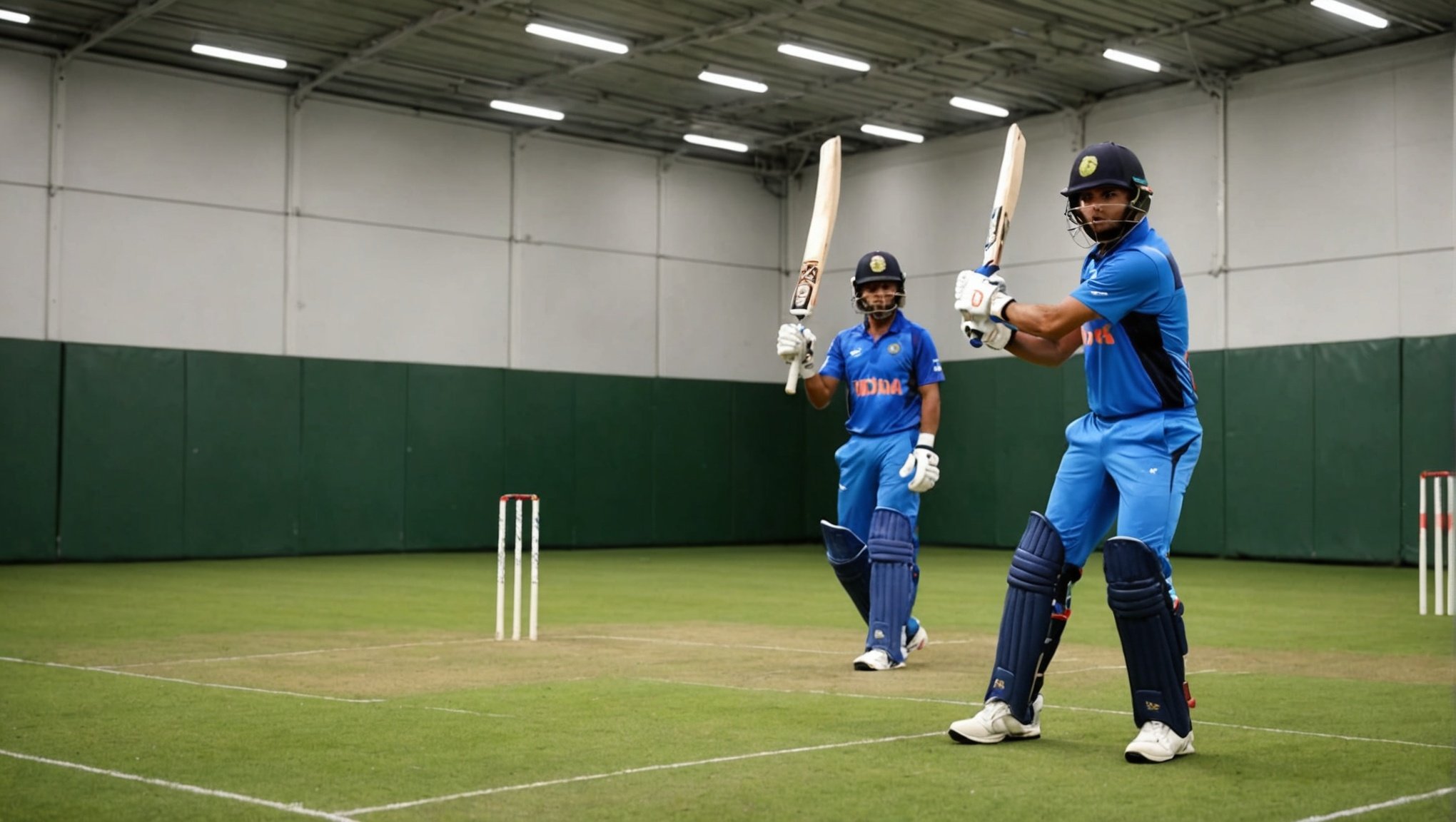Unlocking Indoor Cricket Success: Essential Strategies for Mastering Tactical Gameplay
Indoor cricket, a fast-paced and strategic variant of the traditional game, requires a unique blend of physical skills, mental toughness, and tactical acumen. To excel in this dynamic environment, players and teams must adopt a comprehensive approach that encompasses various aspects of the game. Here’s a detailed guide on how to unlock indoor cricket success through effective strategies and tactics.
Understanding the Game Dynamics
Indoor cricket is played on a smaller, enclosed court with modified rules to accommodate the indoor setting. This version of the game is characterized by its quick pace, limited space, and the need for swift decision-making.
In the same genre : Mastering Middle-Distance: Top Pacing Strategies for Race Day Success
Key Differences from Outdoor Cricket
- Smaller Playing Area: The indoor court is significantly smaller than an outdoor cricket field, which means players have less time to react and more emphasis is placed on quick reflexes and precise movements.
- Modified Rules: Indoor cricket often includes rules such as no LBW (leg before wicket), limited overs, and specific restrictions on field placements to ensure a balanced and exciting game.
- Equipment: The ball used in indoor cricket is lighter and has a softer core to reduce the risk of injury and damage to the playing area.
Building a Strong Team
A successful indoor cricket team is built on a foundation of diverse skills, effective communication, and a well-defined game plan.
Selecting the Right Players
When building your team, it’s crucial to select players with a range of skills:
Also to see : Top Strength Training Workouts for Elite Lugers: Unlock Your Athletic Potential
- Batters: Look for players with high batting averages and the ability to score quickly.
- Bowlers: Fast and accurate bowlers who can adapt to the indoor conditions are essential.
- Fielders: Agile and alert fielders who can cover the smaller court efficiently.
- All-Rounders: Players who can bat, bowl, and field are invaluable in indoor cricket due to the limited number of players.
Effective Communication
Communication is key in any team sport, and indoor cricket is no exception. Here are some tips to enhance team communication:
- Pre-Game Briefings: Discuss the game plan, opponent strengths and weaknesses, and individual roles.
- Real-Time Feedback: Encourage players to provide immediate feedback during the game to adjust strategies.
- Non-Verbal Cues: Use hand signals and body language to communicate quickly and efficiently.
Tactical Analysis and Game Plan
A well-thought-out game plan is essential for success in indoor cricket. Here’s how you can develop a tactical approach:
Analyzing Opponent Strengths and Weaknesses
Before each match, conduct a thorough analysis of your opponent:
- Batting Strengths: Identify their top batters and the types of deliveries they prefer.
- Bowling Weaknesses: Look for bowlers who are prone to errors or have specific weaknesses.
- Fielding Patterns: Study their fielding placements and movements to exploit gaps.
Developing a Game Plan
Based on your analysis, develop a game plan that includes:
- Batting Strategy: Decide on the batting order, target areas for scoring, and the pace of the innings.
- Bowling Tactics: Choose the right bowlers for specific situations and set fielding placements accordingly.
- Fielding Positions: Place fielders in areas where the opponent is likely to score, using data from previous matches.
Mastering Tactical Gameplay
Tactical gameplay in indoor cricket involves a combination of individual skills and team coordination.
Passing Accuracy and Ground Passes
In indoor cricket, passing accuracy is crucial due to the limited space:
- Practice Ground Passes: Regularly practice ground passes to ensure precision and speed.
- Use of the Right Stick: In video game simulations or training drills, using the right stick to control the direction and speed of passes can help in real-world applications.
High Pressure and Ball Roll
Applying high pressure and managing the ball roll effectively can significantly impact the game:
- High Pressure Defense: Employ high-pressure defensive tactics to restrict the opponent’s scoring opportunities.
- Ball Roll Management: Understand how the ball behaves on the indoor surface and adjust your fielding and bowling accordingly.
Skill Moves and Fake Shots
Individual skills such as skill moves and fake shots can be game-changers:
- Skill Moves: Practice advanced skills like reverse sweeps, switch hits, and scoop shots to confuse the opponent.
- Fake Shots: Use fake shots to deceive the bowler and fielders, creating scoring opportunities.
Real-Time Adjustments and Decision Making
Indoor cricket is a fast-paced game that requires real-time adjustments and quick decision-making.
Adjusting the Game Plan
Be prepared to adjust your game plan based on the game’s progression:
- Monitor Opponent’s Strategy: Continuously assess the opponent’s strategy and adjust your tactics accordingly.
- Use Data Insights: Utilize real-time data and analytics to make informed decisions during the game.
Decision Making Under Pressure
Develop the ability to make quick and effective decisions under pressure:
- Stay Calm: Maintain a calm and focused mindset to make rational decisions.
- Trust Your Instincts: Trust your training and instincts to make swift decisions.
Managing Your Bankroll and Avoiding Common Pitfalls
While indoor cricket is not typically associated with betting, the principles of managing resources and avoiding pitfalls can be applied to team management and player performance.
Resource Management
Manage your team’s resources effectively:
- Player Rotation: Rotate players to avoid fatigue and ensure everyone gets a chance to contribute.
- Injury Management: Monitor player injuries and have a plan for substitutions.
Avoiding Common Pitfalls
Avoid common pitfalls that can hinder your team’s performance:
- Overconfidence: Avoid becoming overconfident after a few wins; stay focused and adaptable.
- Lack of Communication: Ensure that communication remains a priority throughout the game.
Tools and Technologies for Enhanced Performance
Modern technologies and tools can significantly enhance your indoor cricket performance.
AI and Machine Learning
Utilize AI and machine learning tools to analyze game data and improve strategies:
- Data Analysis: Use tools like ZCode or OddsJam to analyze historical data, player stats, and match outcomes to refine your tactics.
- Predictive Analytics: Employ predictive analytics to forecast game outcomes and identify profitable betting opportunities, even though this is more relevant to sports betting, the analytical skills can be transferred.
Training Software and Simulators
Use training software and simulators to practice and perfect your skills:
- Video Game Simulations: Games that simulate cricket can help you practice skill moves, passing accuracy, and tactical decision-making.
- Virtual Training Drills: Participate in virtual training drills to improve your reflexes and reaction times.
Practical Insights and Actionable Advice
Here are some practical insights and actionable advice to help you master indoor cricket:
Pre-Game Preparation
- Physical Conditioning: Ensure that all players are physically fit and well-conditioned.
- Mental Preparation: Conduct pre-game mental preparation sessions to focus the team.
In-Game Strategies
- Start Strong: Begin the game with a strong batting or bowling performance to set the tone.
- Adapt Quickly: Be ready to adapt your strategy based on the game’s progression.
Post-Game Analysis
- Review Performance: Conduct a thorough review of the game to identify areas for improvement.
- Adjust Strategies: Make necessary adjustments to your strategies based on the analysis.: Fueling Your Way to Indoor Cricket Success
Indoor cricket success is not just about individual skills; it’s about combining those skills with tactical acumen, effective communication, and real-time adjustments. By understanding the game dynamics, building a strong team, conducting thorough tactical analysis, and leveraging modern tools and technologies, you can unlock your team’s full potential.
Final Tips
- Stay Flexible: Be prepared to adjust your strategies as the game unfolds.
- Communicate Effectively: Ensure that communication remains a priority throughout the game.
- Practice Consistently: Regular practice is key to mastering the skills and tactics required for indoor cricket.
In the words of a seasoned indoor cricket coach, “The key to success in indoor cricket is not just about hitting the ball hard or bowling fast; it’s about understanding the game, adapting quickly, and executing your strategies with precision and teamwork.”
By following these essential strategies and tips, you can elevate your indoor cricket game and lead your team to victory. Remember, every match is an opportunity to showcase not only your skills but also your tactical prowess and team spirit.













